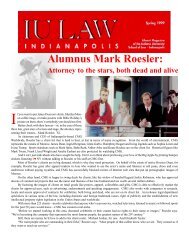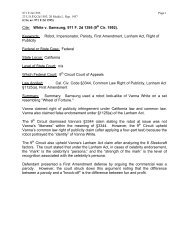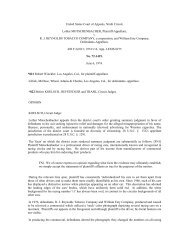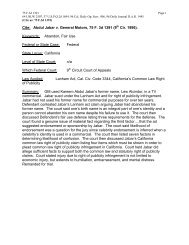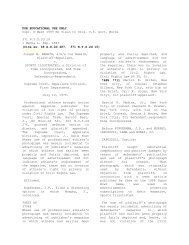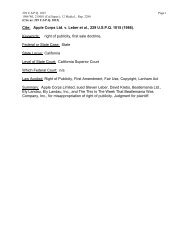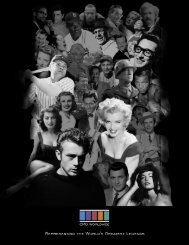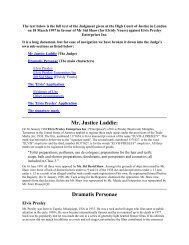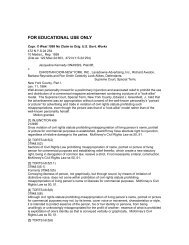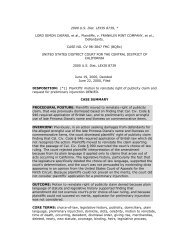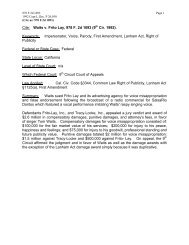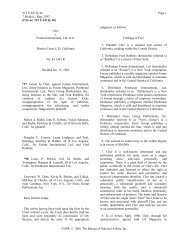Hustler v. Falwell.pdf - Mark Roesler
Hustler v. Falwell.pdf - Mark Roesler
Hustler v. Falwell.pdf - Mark Roesler
You also want an ePaper? Increase the reach of your titles
YUMPU automatically turns print PDFs into web optimized ePapers that Google loves.
Contemporary events, symbols and people are regularly use in fictional works.<br />
Fiction writers may be able to more persuasively, more accurately express<br />
themselves by weaving into the take persons or events familiar to their readers.<br />
The choice is theirs. No author should be forced into creating mythological<br />
worlds or characters wholly divorced from reality. The right of publicity<br />
derived from public promienence does not confer a shield to ward off<br />
caricature, parody and satire. Rather, prominence invites creative comment.<br />
Id. 160 Cal. Rptr. at 358. As the court concluded with respect to Valentino,<br />
since Rogers and Astaire are similarly "part of the cultural history of an era,"<br />
their fame is an equally "apt topic" for Fellini's fictional work. See id.<br />
- - - - - - - - - - - - - - - - - -Footnotes- - - - - - - - - - - - - - - - - -<br />
PAGE 38<br />
695 F. Supp. 112, *123; 1988 U.S. Dist. LEXIS 8694, **34;<br />
8 U.S.P.Q.2D (BNA) 1562; 15 Media L. Rep. 2097<br />
n6 The holding in Guglielmi is set forth in a brief per curiam opinion<br />
stating that in accordance with Lugosi v. Universal Pictures, 25 Cal. 3d 813,<br />
160 Cal. Rptr. 323, 603 P.2d 425 (1979), decided the same day, since California<br />
did not recognize a descendible right of publicity, the complaint was properly<br />
dismissed. Chief Justice Bird addressed the First Amendment concerns raised by<br />
the plaintiffs' claims in the concurring opinion, discussed below, which she<br />
authored for an alternate majority of the court.<br />
- - - - - - - - - - - - - - - - -End Footnotes- - - - - - - - - - - - - - - - -<br />
[**35]<br />
Finally, Chief Justice Bird's opinion explained why the use of Valentino's<br />
name in advertising the film was equally protected and permissible:<br />
A similar result is called for the use of Valentino's name and likeness in<br />
advertisements for the film. That use was merely an adjunct to the exhibition of<br />
the film. It was not alleged that the advertisements promoted anything but the<br />
film. Having established that any interest in financial gain in producing the<br />
film did not affect the constitutional stature of respondents' undertaking, it<br />
is of no moment that the advertising may have increased the profitability of the<br />
film. It would be illogical to allow respondents to exhibit the film but<br />
effectively preclude any advance discussion or promotion of their lawful<br />
enterprise. Since the use of Valentino's name and likeness in the film was not<br />
actionable infringement of Valentino's right of publicity, the use of his<br />
identity in advertisements for the film is similarly not actionable. [*124]<br />
Id. at 360. This rationale applies with equal force to Rogers' claims concerning<br />
promotion of the Film in the United States. Since Fellini's right to use Rogers<br />
and Astaire as a cultural reference point in this [**36] film is protected,<br />
the related advertising cannot be actionable.<br />
The cases on which Rogers primarily relies to support her right of<br />
publicity claim can be distinguished from the instant case. In Zacchini v.<br />
Scripps-Howard Broadcasting Co., 433 U.S. 562, 53 L. Ed. 2d 965, 97 S. Ct.<br />
2849<br />
(1977), the plaintiff performed a "human cannonball" act which the defendant<br />
broadcast on a news program. In a narrowly drawn opinion effectively limited to<br />
its facts, the Supreme Court held that the First Amendment did not bar the



